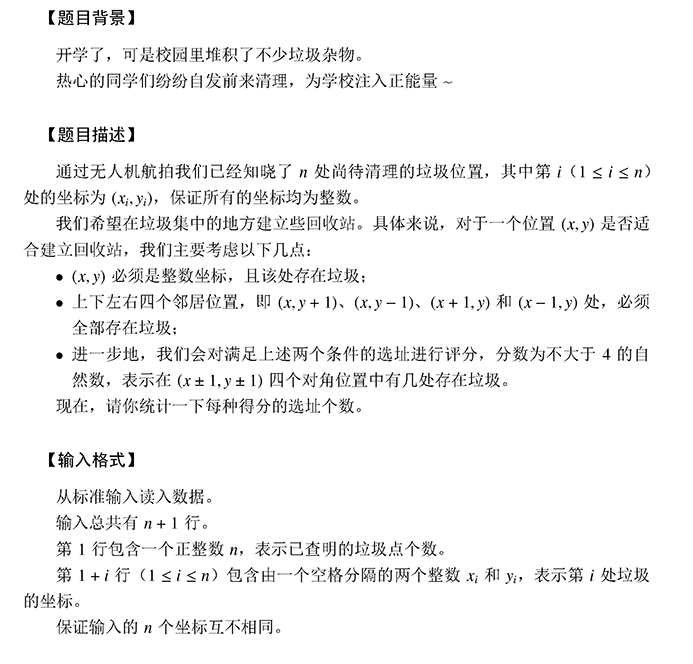TreeMap和HashMap的元素比较
写在前面的话
2021.04,准备面试和CCF CSP认证的我准备做一套CCF模拟题,然后就有了此篇博客(x
题目:201912-2 回收站报数
题目截图:

第一个想法:读取每个垃圾的位置,存入TreeSet中,然后依次取出判断是否可以建立回收站和评分(不可以建立回收站,评分为-1)。
这时候就有读者要问了:啊这你为什么要使用TreeSet呢?不使用HashSet呢?
我回答:因为输出需要顺序啊,HashSet输出是(没有顺序的)不保证有序的,即有可能出现有序但是程序设计不能依赖于此。
读者:噢,原来如此。
做完题目的我:一看你就是一大段文字不喜欢看(x,题目都没看清(别骂了,我也是🤡),题目最后的输出是需要统计每种得分的个数,不需要有序,用HashSet完全是足够了。
读者:WTF,一种植物。
但是在我看错题目的解题过程中(hhh),出现了错误,准确的说是TreeSet的使用错误,这篇博客记录一下错误和过程。
TreeSet compare和contains
错误现象
在上述题目中,笔者使用的是TreeSet进行排序,然后每一个依次判断输出,但是最后输出的结果全部都是4,所有的垃圾点都是回收站并且评分都是4,即对于任意一个垃圾,周围8个边界都存在垃圾。
错误代码
这是我进行判断并且计算评分的代码:
public static int score(int x, int y, Set<Point1912> set) {
if (set.contains(new Point1912(x + 1, y)) && set.contains(new Point1912(x - 1, y)) && set.contains(new Point1912(x, y + 1)) && set.contains(new Point1912(x, y - 1))) {
int sum = 0;
sum += (set.contains(new Point1912(x + 1, y + 1)) ? 1 : 0);
sum += (set.contains(new Point1912(x - 1, y + 1)) ? 1 : 0);
sum += (set.contains(new Point1912(x + 1, y - 1)) ? 1 : 0);
sum += (set.contains(new Point1912(x - 1, y - 1)) ? 1 : 0);
return sum;
} else {
return -1;
}
}
坐标类
class Point1912 {
int x = 0;
int y = 0;
int seq = 0;
public Point1912(int x, int y) {
this.x = x;
this.y = y;
}
public Point1912(int x, int y, int seq) {
this.x = x;
this.y = y;
this.seq = seq;
}
@Override
public boolean equals(Object obj) {
Point1912 p = (Point1912) obj;
return x == p.x && y == p.y;
}
@Override
public int hashCode() {
return Objects.hash(x, y);
}
}
TreeSet代码
TreeSet<Point1912> set1 = new TreeSet<>(((o1, o2) -> o1.seq - o2.seq));
很明显,在判断的代码中任意的set.contains()都返回了true,但是在坐标类中我明确设计了equals和hashCode方法,保证只有坐标相等的时候才能返回true。
调试
查看源码
最终的比较源码,位置在TreeMap.java
final Entry<K,V> getEntryUsingComparator(Object key) {
@SuppressWarnings("unchecked")
K k = (K) key;
Comparator<? super K> cpr = comparator;
if (cpr != null) {
Entry<K,V> p = root;
while (p != null) {
int cmp = cpr.compare(k, p.key);
if (cmp < 0)
p = p.left;
else if (cmp > 0)
p = p.right;
else
return p;
}
}
return null;
}
问题就出现在这里了,TreeSet.contains()方法最终在这里进行比较,重点在于该函数使用的是comparator,这个比较器便是TreeMap用于排序的比较器。因为进行判断的元素seq都是默认值,所以判断是否存在的函数要么全部返回false,要么全部返回true,因为我设置seq默认为0,TreeSet中一定存在所以contains全为true。
解决方案
使用HashSet存储坐标,同时使用另一个ArrayList或者数组存储坐标保证顺序。
下面是HashSet.contains()方法的内容,位置HashMap.java
final Node<K,V> getNode(int hash, Object key) {
Node<K,V>[] tab; Node<K,V> first, e; int n; K k;
if ((tab = table) != null && (n = tab.length) > 0 &&
(first = tab[(n - 1) & hash]) != null) {
if (first.hash == hash && // always check first node
((k = first.key) == key || (key != null && key.equals(k))))
return first;
if ((e = first.next) != null) {
if (first instanceof TreeNode)
return ((TreeNode<K,V>)first).getTreeNode(hash, key);
do {
if (e.hash == hash &&
((k = e.key) == key || (key != null && key.equals(k))))
return e;
} while ((e = e.next) != null);
}
}
return null;
}
可以这里便是采用key.equals的方法进行比较,重写equals起了作用。
同时这个first instance of TreeNode 可以看到HashMap中如果同一个桶的元素超过了7个,在Java1.8中就就将链表转换为了红黑树,Node变成了TreeNode。
总结
TreeMap中元素的比较采用的是Comparator,或者是元素实现的Comparable接口;
HashMap中元素的比较便是元素的equals方法。
如果没看错题目,估计也没这茬子事(嘤嘤嘤x.x)

